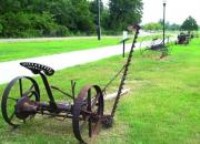Milam County Historical Commission
Milam County, Texas
Milam County, Texas






Take a walk into the past
by Jeanne Williams
Temple Daily Telegram - September 15, 2008
The Milam County Historical Museum in Cameron has
provided a permanent exhibit of antique farm implements
along the walking trail near the new Cameron City Park
complex. (Shirley Williams/Telegram)
CAMERON - The mail-order Montgomery Ward Model 104 hay baler, and John Deere Model
E735A one-row cultivator and other farm machinery kinfolks from the 1890s often went
unnoticed in their casual displays outdoors as visitors perused the Milam County
Historical Museum’s antique collections inside the old jail building.
Today, these six antique implements have no problem getting their fair share of
attention. Since last summer, they have comprised a permanent exhibit along the new
hike and bike trail on North Fannin Avenue near the new Cameron City Park complex.
Aside from the hay baler and cultivator, the exhibit boasts a McCormick No. 6 horse
drawn hay mower, Model 1435, manufactured in Chicago; a horse drawn hay rake’ a Kenwood
No. 4 sugar cane press and an Ideal horse drawn hay mower manufactured by Deering
Harvester Co.
Milam County Historical Museum Director Charles King researched a history of farming,
which is presented in placards along the exhibit, but details of each piece of
equipment and the year it debuted were not available. The items are believed to be from
1890, the year agriculture became increasingly mechanized, King said.
In the 18th century, horsepower pulled wooden plows, while sowing, cultivating and
harvesting was done by hand. The cradle and scythe were introduced in the 1790s, with
the cotton gin invented in 1793. Cast iron plows debuted in 1797 and were replaced in
the early 1800s with steel plows. Then came reapers, and threshing and mowing machines.
By 1830, farmers labored in their fields with walking plows, brush harrows, hand
broadcasting seeds, and using a sickle and flail for harvesting.
Sprockets, cogs, gears, teeth, sickle bar cutters, rakes, iron wheels, and iron seats
for the operator appear to be tortuous equipment to today’s farmers, but simple
mechanics of this equipment were forerunners to the current selection of sophisticated
farm equipment, said Jon Gersbach, Texas AgriLife Extension agent for ag and natural
resources in Milam County.
Farmers were ecstatic at the prospect of driving a team of horses, oxen or mules over a
five-acre field from sun-up to sundown aboard one of these labor saving devices,
Gersbach said.
In those days, farmers could till one or two rows, while today’s agriculture producers
ride in air conditioned comfort planting a 75-foot wide swath of land in one sweep.
“You can do 300 acres a day or more using GPS for the exact placement of seeds,
herbicides and fertilizers accurately without any overages. You can drive a tractor
with GPS technology,” Gersbach said.
When the museum pieces were new, harvesting was a month-long process. Families would
work 50 to 100 acres “and that is about all they could handle,” he said.
“Today a farmer who has 50 to 100 acres is going to have a hard time paying the fuel
bill. With equipment maintenance, you have to have a sizable amount of land. If you had
100 acres to harvest, you would be farming about a week out of the year. It used to be
that was enough to keep a family of four to five busy year around,” Gersbach said.
“Back then you had to save the seed and they had to process and hand harvest
everything.”
The farming tractors of a century ago were promoted with 26 horse power, while modern
riding mowers have that capacity, he said.
While technology has made tremendous advancements in agriculture - the mechanics of the
1890s tools, for example - sickle bar cutters, are still used, Gersbach said. Today’s
cutters are easier to mount, and alloys used keep tools sharper longer.
Some of the old-time farming methods of using every bit of a harvest are coming back
into fashion, he said.
“Back then, they utilized more of that crop, and we are seeing that trend come back,”
Gersbach said. “Back then they would hand pick or harvest the top of the wheat, ears of
corn, oats, barley, grain sorghum. They would take the fodder out of the back of the
harvester for livestock forage. Then they would turn their cattle in to harvest the
rest.”
Based on the equipment they used, farmers did not have an easy ride when it came to
making a living. The exhibit is valuable in that it gives today’s population a look at
how farming has advanced over the centuries, King said.
“To me, the machines are almost like pieces of sculpture,” King said. “To describe how
they worked is like trying to describe how to run a treadle-type sewing machine.”
.

All articles from the Temple Daily Telegram are published with the permission of the
Temple Daily Telegram.
All credit for this article goes to
Jeanne Williams and the Temple Daily Telegram
Photos by Shirley Williams -
Temple Daily Telegram photographer
Temple Daily Telegram.
All credit for this article goes to
Jeanne Williams and the Temple Daily Telegram
Photos by Shirley Williams -
Temple Daily Telegram photographer